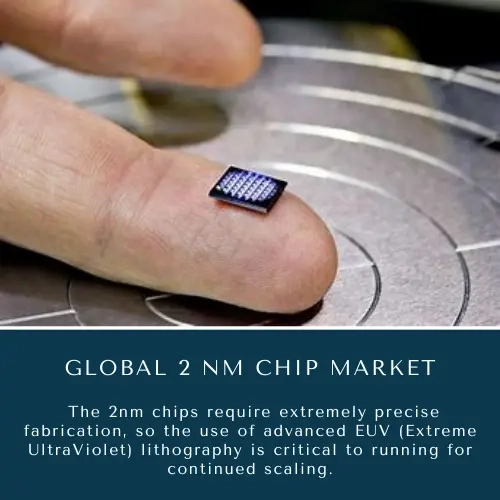
- Get in Touch with Us

Last Updated: Apr 25, 2025 | Study Period:
The 2nm chip segment is at the forefront of semiconductor technology and offers advantages in terms of performance, power efficiency as well miniaturization. The move to 2nm processors is significant as semiconductor makers work to push the limits of Moore's Law. Semicon giants like TSMC, Intel, and Samsung are driving the innovation here by betting big on R&D to tackle this impending challenge of fabricating at scales reaching atoms. A 2nm chip is poised to disrupt markets such as consumer electronics, data centers, automotive, and healthcare by making powerful devices even more so while using less power.
Among these, the growing requirement for high-performance computation linked with data processing activities is the core reason behind the growth of the global 2nm chip market. As the market increasingly relies on applications like machine learning, artificial intelligence and big data analytics that require a lot of compute power suitable chips are in demand with low-power consumption.

The smaller size of 2nm chips results in reduced transistor scale, which subsequently makes the delivery of higher density and lower power consumption possible. Energy efficiency and processing power could be particularly significant in data centers or high-performance computing systems, which explains why Intel is emphasizing those benefits to drive interest from customers going forward.
2nm chips will also have implications for consumer electronics. By designing on smaller process nodes, more compact and feature-rich devices such as smartphones, tablets, or wearable technology can be created. The faster processing speeds, longer battery life and more advanced features enabled by 2nm chips can further improve the user experience. This, in turn, is expected to spawn demand for 2nm chip technology as adding more functionality into the same small form factor paves the way for further consumer electronic innovation.
The 2nm chip market is poised to benefit from the continuous innovation in semiconductor manufacturing and growing demand for high-speed, energy-efficient I/O Boosts Servers. That's why continued R and D investment by the world-leading semiconductor companies will be critical to solving some of the technical problems in 2nm chip fabrication, and difficult issues around lithography and materials science. In addition, as emerging technologies such as quantum computing and 5G communications grow, new possible areas for the use of 2nm chips will likely provide continuous growth in this market.
The 2nm chip is a verbal milestone in semiconductor industry history, where performance, energy efficiency, and reduced form factor size are all tested. For semiconductor producers, meeting Moore's Law and moving to a smaller process node like 2nm is the biggest generational jump. This is setting up these chips to change how things are done in industries from consumer electronics and data centers, to automotive and healthcare. Smaller transistor size = more transistors per given area, which means better performance and less power usage -- two key factors that dictate the development of computing technology over time.
One of the most impressive stories around 2nm chips is how complicated they are to produce. State-of-the-art fabrication techniques, for example, extreme ultraviolet (EUV) lithography to etch patterns at the nanometer scale are needed to make such small transistors. Manufacturing make-up of these capabilities has been years in the making through research and investment efforts at a significant scale The chips themselves are not only jam-packed with billions of transistors crammed into the tiniest area but also have a bunch of new material and design enhancements to increase power efficiency and life.
However, 2nm chips hold implications that are not just regarding better performance. Thanks to the improved efficiency and reduced power consumption in these chips, they are perfect for battery-operated gadgets such as smartphones but not being limited you can find them also inside laptops or wearables where this extra juice is pretty much important. Of course, the increased processing power of 2nm chips also gives way to improved AI (artificial intelligence), MLM( machine learning models), and other data-heavy applications. On the whole, more processing power and less energy consumption will help data centers especially run larger clouds.
In the meantime, 2nm chips will continue to spark innovation throughout many industries in the time ahead. For instance, 2-nm chips will improve ADAS or autonomous vehicles within automotive because faster and more responsible decisions can be made which results in a safer and lower latency performance. The adoption of 2nm chips in healthcare will enable the creation of smarter diagnostic tools and wearable devices that ultimately result in better patient outcomes with increasingly personalized medicine. With the evolution of semiconductor technology, the 2nm chip is a milestone that could lead to almost infinite computing power and eventually new technological wonders.

The Global 2nm Chip Market was valued at $XX Billion in 2023 and is projected to reach $XX Billion by 2030, reflecting a compound annual growth rate (CAGR) of XX% from 2024 to 2030.
Gate-All-Around (GAA) Transistor Technology:
Using GAA transistor technology in 2nm chips focuses better on electrostatic control over the channel, reducing leakage and enhancing performance. For those who can scale their semiconductor devices, this technology keeps them scaling further and delivering superior performance per watt in advanced computing applications.
Improved Material Engineering
For 2nm chips, the use of exotic new materials like high-mobility channel materials and cost-effective advanced dielectric layers is essential. Such vehicle materials help to improve electron mobility and minimize power dissipation, which goes a long way in developing fast semiconductor devices.
3D Chip Stacking:
A strategy vertically where multiple layers of semiconductor components are being stacked to increase device density & performance. The approach advances computational efficiency and minimizes interconnect delays, allowing a class of more powerful large-scale semiconductor solutions that are optimized for high-performance computing.
Advanced Lithography Technologies:
The use of advanced lithography technologies such as extreme ultraviolet (EUV) lithography is a prerequisite for production accuracy in chips as small and dense as 2nm. Because of the application, these methods allow the production of smaller yet denser transistor chips that increase their overall performance and enable more times miniaturization of electronic devices.
IBM 2nm Nanosheet Technology:
IBM's 2nm chip utilizes the nanosheet operation method allowing for a faster increase in performance and reduction of energy use levels by up to five times compared to the existing state-of-the-art, 7 nm chips. This advancement increases the speed and performance of AI/ML & computational applications opening up room for new, higher-power devices operating at a lower power-efficiency budget.
TSMC 2nm Process:
The 2nm process technology of TSMC uses gate-all-around (GAA) transistors to enhance performance and reduce power consumption. Production is slated to start in 2024. TSMC's 2nm chips are to fuel AI, IoT, and HPC evolution - more efficient and powerful semiconductor products.
Intel 20A (2nm Equivalent):
20A is equal to about 2nm and it brings two innovations RibbonFETs, which have been available for years in IBM Z mainframe processors, as well as PowerVi as both improve performance and power efficiency. It represents a major leap forward on Intel's semiconductor technology roadmap This will integrate with ProAptiv CPUs, an active C-based device that offers enhanced performance and power efficiency for next-generation devices running on modern AI architectures.
Samsung 2nm GAA Process:
With GAA, the new 2nm process technology can have improved performance and reduce power consumption. This will enable us to change the face of mobile and AI applications. Samsung 2nm chips will be the foundation for a new paradigm in semiconductor advancements, enabling innovative and powerful solutions in mobility, AI models, or HPC deployment.
| Sl no | Topic |
| 1 | Market Segmentation |
| 2 | Scope of the report |
| 3 | Abbreviations |
| 4 | Research Methodology |
| 5 | Executive Summary |
| 6 | Introduction |
| 7 | Insights from Industry stakeholders |
| 8 | Cost breakdown of Product by sub-components and average profit margin |
| 9 | Disruptive innovation in the Industry |
| 10 | Technology trends in the Industry |
| 11 | Consumer trends in the industry |
| 12 | Recent Production Milestones |
| 13 | Component Manufacturing in US, EU and China |
| 14 | COVID-19 impact on overall market |
| 15 | COVID-19 impact on Production of components |
| 16 | COVID-19 impact on Point of sale |
| 17 | Market Segmentation, Dynamics and Forecast by Geography, 2024-2030 |
| 18 | Market Segmentation, Dynamics and Forecast by Product Type, 2024-2030 |
| 19 | Market Segmentation, Dynamics and Forecast by Application, 2024-2030 |
| 20 | Market Segmentation, Dynamics and Forecast by End use, 2024-2030 |
| 21 | Product installation rate by OEM, 2023 |
| 22 | Incline/Decline in Average B-2-B selling price in past 5 years |
| 23 | Competition from substitute products |
| 24 | Gross margin and average profitability of suppliers |
| 25 | New product development in past 12 months |
| 26 | M&A in past 12 months |
| 27 | Growth strategy of leading players |
| 28 | Market share of vendors, 2023 |
| 29 | Company Profiles |
| 30 | Unmet needs and opportunity for new suppliers |
| 31 | Conclusion |
| 32 | Appendix |